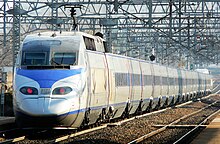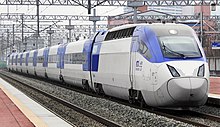Korea Train Express

|
|
| Korean spelling | |
|---|---|
| Korean alphabet : | 한국 고속철도 |
| Hanja : | 韓國 高速 鐵道 |
| Revised Romanization : | Han-guk Gosok Cheoldo |
| McCune-Reischauer : | Hanguk Kosok Ch'ŏldo |
The Korea Train eXpress (short: KTX ) is a series of South Korean high-speed trains . The operators are the South Korean railway companies Korail and SR . In April 2018, KORAIL had a total of 1530 vehicles ( power cars and passenger cars ) available for the trains .
history
A feasibility study was carried out between 1973 and 1984 . In May 1989 the construction of the line between Seoul and Busan was decided, in December of the same year a 54-person working group was founded in the administration of the state railway . The large-scale route was established in June 1990. In February 1991 a planning group was established for the project.
In 1991, German and French providers competed to implement the route and vehicle concept . In this context, an ICE 1 was shown abroad for the first time in February and March 1991 . The award of the contract has been postponed several times.
In December 1991 a law on the track construction company was passed, which was founded in March 1992 with 7 departments and 379 employees. In June 1992 the construction of a 57.2 km long test section between Chonan and Taejon began. In June 1994 the system was selected and the contract for the route was signed.
At the beginning of 1998 delays and cost increases became known. The opening of the line between Seoul and Busan should therefore be delayed until 2005, the costs rise by 50 percent to the equivalent of around 34.5 billion DM. In the summer of 1998, further delays due to a financial crisis became known. A new government in Seoul only approved the building on the condition that the costs were significantly reduced. In addition, it was examined whether the southern section (between Taejon and Busan) should not be realized and instead expand and electrify the existing line. In June 1998 a two-stage realization of the new line was announced: The 250 km long northern section should go into operation as planned in 2004, while the southern section should not be built until 2006. A construction period of six years was planned for the southern section.
On December 16, 1999, the section between Seoul and Busan was officially opened in the presence of South Korean President Kim Dae-jung .
Scheduled operations began on April 1, 2004 . Around 26 pairs of trains ran between Seoul and Busan each day, and then seven pairs of trains ran daily to Mokpo. In the first few days of operation, numerous trains between Seoul and Busan were fully booked. The official opening of the Gyeongbu and Honam routes took place on March 31, 2004 after a twelve-year development phase.
vehicles
KTX
The trains were called KTX from the end of 1999 and are the first generation of high-speed trains in South Korea. Twelve of the 46 multiple units were built by Alstom in France, the rest - with Alstom's participation - built in South Korea. South Korea became the eighth country to rely on TGV technology; it was also the first Asian country to opt for this technology.
The train reaches a regular speed of more than 300 km / h. This is done by twelve electric motors , each with an output of 1,130 kW. A total of 13,560 kW is achieved as a total output, this corresponds to approximately 18,200 PS. The KTX I is essentially a TGV-A model that has been slightly modified. A total of 46 trains are to be built. The first twelve are or were produced in France by Alstom , the remaining 34 units are to be produced by the South Korean company Hyundai Rotem. The track construction was also carried out with the help of French SNCF engineers. The next generation of the KTX HSR-350x is based on the TGV-R . About 80% of the train is produced in South Korea. The first units entered service in 2008.
KTX-Sancheon
At the beginning of March 2010, the trains, known as KTX-Sancheon (also KTX II), went into commercial use . Ten of the trains developed by Hyundai Rotem over almost 15 years have been in operation since the end of 2010. They run at a scheduled top speed of 300 km / h. The trains are made up of 10 vehicles and can run in double traction if necessary .
HEMU
In a next step, another train was developed. It is called a High-speed Electric Multiple Unit (HEMU). During test drives in 2013 it reached a speed of 421 km / h. The trains are to be used in scheduled traffic from 2020.
traffic
When high-speed traffic started in 2004, 54,000 travelers used the KTX every day. April 2018 there were 170,000.
Incidents
On December 8, 2018, a KTX II derailed on the way from Gangneung to Seoul a few minutes after departure at a switch at a speed of 103 km / h. 15 people were slightly injured.
Web links
- Articles and pictures on hochleistungszuege.com
- Information about KTX (English)
literature
- KORAIL: KORAIL embarks on a New Journey to Its Long-Cherished Desire, Trans Eurasian Railway, for the Bright Future of Korea . In: OSJD Bulletin 2/2019, pp. 9-15.
- Ministry of Land, Infrastructure and Transport of the Republic of Korea: Developement of Railway Transport in the Republic of Korea . In: OSJD Bulletin 2/2019, pp. 1–8.
- NN: The Korea Train Express - a TGV for South Korea . In: Eisenbahn-Revue International , Issue 4/2004, ISSN 1421-2811 , pp. 162-169.
Individual evidence
- ↑ KORAIL: KORAIL embarks , p. 9.
- ↑ a b c d e f Trial operation on the South Korean high-speed line . In: Eisenbahn-Revue International , issue 5/2000, ISSN 1421-2811 , p. 225.
- ^ Berndt von Mitzlaff: High-speed traffic abroad. In: Editor (Ed.): High-speed traffic. Hestra-Verlag, Darmstadt 1991, ISBN 3-7771-0234-2 ( Yearbook of the Railway System . Volume 42), p. 80.
- ^ Message Korea's TGV starts later . In: Eisenbahn-Revue International , Edition 3, 1998, ISSN 1421-2811 , p. 104
- ↑ Report financial crisis slows down high-speed traffic . In: Eisenbahn-Revue International , Issue 7/8, 1998, ISSN 1421-2811 , p. 322
- ↑ News update shortly . In: Eisenbahn-Revue International , Issue 9, 1998, ISSN 1421-2811 , p. 380.
- ↑ Message KTX in operation . In: Eisenbahn-Revue International , issue 5/2004, ISSN 1421-2811 , p. 221.
- ↑ Without a source
- ↑ Without a source
- ↑ High-speed trains in Korea on high- speed trains
- ^ Ministry: Developement , p. 7.
- ^ Ministry: Developement , p. 7.
- ^ Ministry: Developement , p. 7.
- ↑ KORAIL: KORAIL embarks , p. 9.
- ↑ Severe derailment in South Korea . In: Eisenbahn-Revue International . No. 2 , February 2019, ISSN 1421-2811 , p. 86 .


